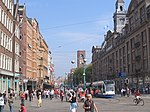Sexmuseum Amsterdam

The Sexmuseum or the Temple of Venus (Dutch: Venustempel) is a sex museum located in Amsterdam, Netherlands. The museum opened in 1985. It had 675,000 visitors in 2015, making it one of the most visited museums in the Netherlands.The museum features an extensive collection of pictures, recordings, photos, paintings and artifacts which allow visitors to explore the evolution of human sexuality throughout the ages. Exhibits present the history of sex and how it has evolved over the centuries. From Cleopatra's regiment of men, to the Romans’ insatiable appetite for sex, to the repressive Middle Ages, visitors are presented with how sex was viewed throughout historical civilizations.
Excerpt from the Wikipedia article Sexmuseum Amsterdam (License: CC BY-SA 3.0, Authors, Images).Sexmuseum Amsterdam
Damrak, Amsterdam Centrum
Geographical coordinates (GPS) Address Website External links Nearby Places Show on map
Geographical coordinates (GPS)
| Latitude | Longitude |
|---|---|
| N 52.3765923 ° | E 4.8972585 ° |
Address
Venustempel Sexmuseum
Damrak 18
1012 LH Amsterdam, Centrum
North Holland, Netherlands
Open on Google Maps









